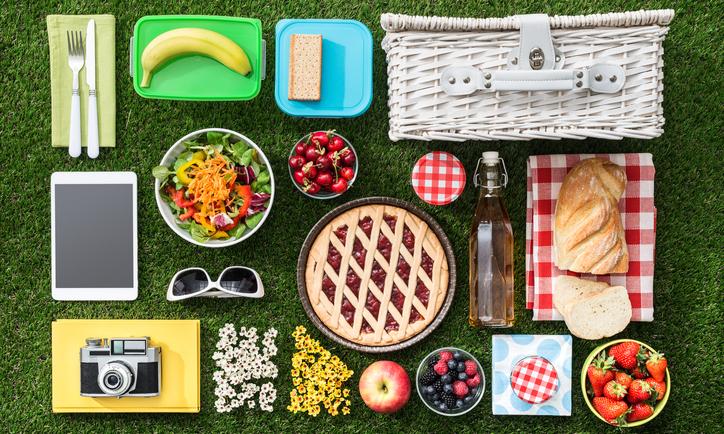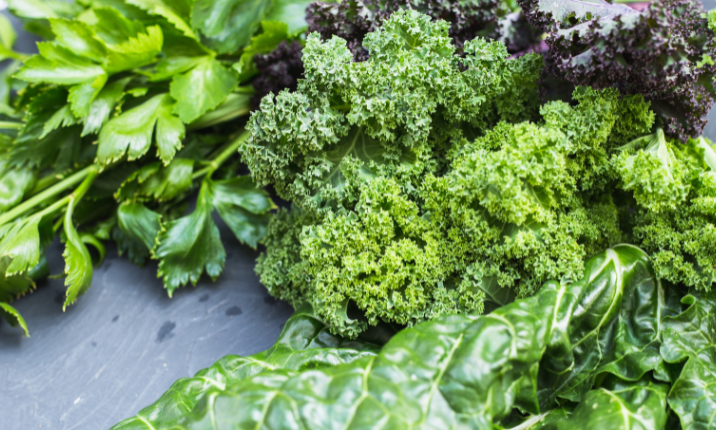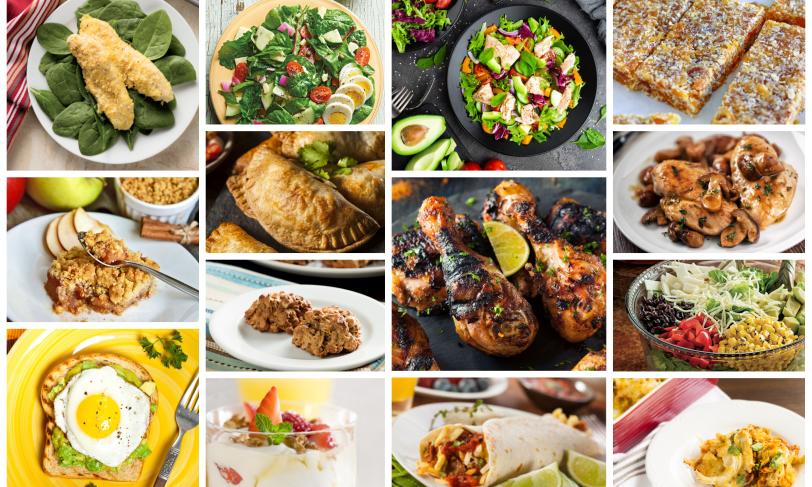As we move into the new year and thoughts turn to healthy resolutions and diabetes meal planning, the Diabetes Food Hub team looked back at the first year of the site and reviewed the most popular recipes as determined by, you, our visitors. Favorites ranged from a low-carb chicken and mushroom superstar to breakfast frittatas just begging for a personal spin. Altogether, they make a fantastic round up of meals designed to help you be the best you in 2019 and beyond. Click on the slideshow below to see the top crowd pleasers of 2018.
Tag: beverages
-

Planning for a Picnic
Warm weather is a great time to move the meal outdoors. But as you pack your basket and plan for a healthy, diabetes-friendly meal in the open air, there are some tips and tricks you can use to keep your meal savory, safe, and successful. Whether your family is planning a beach trip, picnic, or reunion, food is usually involved. Before you hit the road for your next outing, remember these tips to keep your food fresh while also keeping you and your loved ones healthy and safe.Food Safety
Be sure to plan, portion, and pack your meal with food safety in mind for a worry-free trip.
- Pack smart: Put the popular items, like drinks, on top when you are packing the food. You don’t want to pull out the pasta salad every time someone wants a of water. Better yet, pack drinks and food in separate coolers so the food can stay cold until you are ready to eat.
- Stay out of the Danger Zone: Bacteria can grow quickly when food isn’t stored at the right temperature. Keep cold food at or below 40°F using ice or cool packs and keep hot food at or above 140°F using things like slow cookers and warming plates.
- Keep it cool: Place bags and coolers inside the car and not in the trunk, which can heat up like an oven. You don’t want the Fruit Salad with Honey Yogurt going bad before you make it to your destination.
- Watch the clock: When it’s finally time to enjoy your meal, keep an eye on the clock. Food can spoil if it sits out longer than two hours. On very hot days, don’t leave food out for more than one hour. Keep your food safe by serving it up and keeping the rest of the food in the cooler.
Check out Focus on Food Safety for more food safety tips!
Keeping it Healthy
Picnics, cookouts, BBQs, potlucks—these outdoor feasts are not usually known for their healthy food options. It’s still possible to eat well and have fun with a few simple tips:
- Make it a meal: It’s tempting to pack up all your favorite foods when planning something fun, but remember: it’s still a meal! Try to bring a variety of foods including fruits, non-starchy vegetables, and plenty of water.
- Watch your portions: It’s easy to overeat at cookouts, picnics, and other celebrations where platters of food are readily available for grazing. Keep your portions similar to what you would eat at home, and be sure to use a plate so you know exaclty how much you are eating.
- Want not, waste not: If you think there may be extra food, be prepared with extra containers and plenty of ice and cooler space for proper storage.
Meal Makeovers: Picnic Edition
There are many traditional picnic dishes that you can bring or cook outdoors. There are also many options to ensure that your picnic is flavorful and healthy. Try out some of these meal makeovers of traditional picnic dishes:
Beef burgers
A staple at most cookouts, burgers made of beef are often high in saturated fat. Try using ground chicken or turkey, or try a veggie burger.
Try instead:
Creamy side salads
Potato salad, pasta salad, coleslaw—these classic picnic side dishes are usually coated with creamy mayonnaise, adding lots of fat and calories. Try side salads with lighter dressings.
Try instead:
Dips
Dips are a popular side dish, but they are often cream based, which can add more calories and fat. Try a bean or veggie based dip for something lighter. Sub raw veggies for chips for an even lighter snack.
Try instead:
-

Ask the Experts: All About Carbs
When it comes to carbohydrates and diabetes, it’s hard to make sense of all the information out there. Fat was once seen as the enemy, but in recent years, carbohydrates have taken center stage as the villain to healthy eating. But this “bad guy” reputation doesn’t tell the whole story. So, how much carb should a person with diabetes eat?
First, let’s take a step back and think about what all foods are made of. Most of the calories in our food come from three “macronutrients”: carbohydrate, fat, and protein (“macros” refers to the nutrients our body needs in large amounts). Foods also contain “micronutrients” like vitamins and minerals—these are essential for many of our bodies’ functions, but we need a much smaller amount of them and they don’t usually provide any calories.
High Carb, Low Carb, No Carb?
Should people with diabetes cut back on carbs? It’s true that foods high in carbohydrate have the biggest impact on blood glucose compared with foods high in protein and fat. Carbohydrates break down into glucose after they are digested, so it makes sense to think that cutting carbs would lead to lower blood glucose levels and better diabetes management. However, glucose is also an important fuel source for your brain. Just like a car needs gas, our brain needs glucose. There’s a lot of debate around what is the ideal mix of carbohydrate, protein, and fat needed by people with diabetes, but we don’t have any evidence that one specific proportion will be right for everyone.
Glucose is also an important fuel source for your brain—just like a car needs gas, our brain needs glucose
What kind of Carb Is Just as Important as How Much
There are a lot of carbohydrate food options, and this is where it gets tricky, because some carbs are better for you than others. “Refined” carbs refer to foods made with white flour and sugar, such as pretzels, cookies, cakes, and white breads. These foods raise your blood glucose levels quickly, and do not provide much nutritional value. On the other hand, carbs found in vegetables, beans, lentils, fruit, and whole grains break down slower and are packed with fiber, vitamins, and minerals that provide many health benefits.
The timing and amount of carbs you eat are also important. Eating a lot of carbs in one meal, even if they are high quality carbs, can cause a spike in your blood sugar. Try to spread them across your meals and snacks throughout the day based on your personal carb goal.
And remember, there are many other factors that can affect your blood glucose. Things like changes in activity or sleep, timing and dose of diabetes medicine, and stress can all have an impact on your blood glucose. It’s not always just about food! (You can go here to learn more about other factors that affect your blood glucose)
What Works for You
When deciding how much carb is best for you, start by looking at what you are eating on a regular basis. How many grams of carbohydrate are you eating in each of your meals and snacks? If you are checking your blood sugar, are there certain times of day that your blood sugar is always higher? If so, then that may be the best place to start making small changes. As you continue to make changes, watch for blood glucose trends to help guide the best choices for you.
If you are considering a low carb eating pattern, be sure to think about how much time you are willing to devote to meal planning. Strict low carb eating patterns, such as the ketogenic (keto) diet, require careful planning and regular visits to your doctor to ensure you are getting all of the vitamins and minerals you need to stay healthy.
Some carbs are better for you than others
What can we all agree on when it comes to carbohydrates? Whether you follow a Mediterranean, vegan, keto, low carb, or any other eating pattern, one thing is for sure: Eat plenty of colorful non-starchy vegetables. They are full of vitamins, minerals, dietary fiber, and antioxidants to name just a few. And when it comes to sweet and salty snacks, cutting back is almost always going to help with your blood glucose goals.
Finally, the million dollar question: How many carbohydrates should you eat each day? Well, that choice is yours. With careful review of your blood glucose trends and your usual eating patterns, you can often find the right balance that meets your daily nutrition needs and health goals as well as satisfying your appetite. Remember, the best meal plan for YOU is the one that you can stick with while meeting your health goals and feeling good!
Still need more help? Find a registered dietitian with RD or RDN credentials or ADA Recognized Diabetes Self-Management Education Program to help you fine-tune your eating plan.
-

Tasty Tips for Traveling
Your bags are packed and you’re heading out for a well-deserved vacation. But what about meals and snacks? Whether you’re traveling by car, air or rail, when you’re managing your diabetes, a little planning can make your time on the go a lot less stressful and a lot more fun!
With all of the details to keep track of when planning a trip, meals can end up being a last-minute challenge with limited healthy choices. As a result, it’s easy to get out of your routine, including those habits that help you manage your diabetes day to day. But with a few tips in mind, you can keep up with that healthy routine as if you were right at home.
On the Road or By Plane
As you travel to your vacation destination, your normal routine gets interrupted, and you may be bombarded with a number of snack stands and fast food restaurants tempting you with unhealthy options. Here are a few solutions to common problems you may encounter:
Problem: A long ride ahead of you that interrupts your regular schedule.
Solution: Think about exactly how long your trip will be. Will it conflict with the time you usually eat lunch? Dinner? Mid-day snacks? If so, plan on packing the right amount of food and snacks for those times. This way your meals are just about ready to go and your schedule stays on course.Problem: Overeating! You become so focused on the road, you don’t realize that you’ve already reached the bottom of your snack bag. Even if you have packed healthy options like unsalted mixed nuts, or fresh fruits, overeating some of these healthy foods can lead to higher blood sugar.
Solution: Bring your single-serving containers. Portion snacks into single serving sizes and divide up your food based on the number of meals and snacks you will need while you’re traveling. Think of it as packing a lunch bag, rather than one large bag of snacks.Problem: When traveling by air, you might find yourself with a layover or two, and the airport’s many food temptations can be a challenge.
Solution: Think about packing some foods that don’t need refrigeration. These can be your own bag of trail mix with unsalted nuts, cheese and crackers, or some uncut fresh fruit like an apple or pear. Even carrots and celery hold up pretty well. If you have to buy something at the airport, find healthier options by reading nutrition labels and watching your portion sizes.Maintaining healthy habits on vacation doesn’t have to take away from your experience
Problem: The Transportation Security Administration (TSA) doesn’t allow some food or drinks past the security check points.
Solution: Many people are confused about this rule. Actually, while TSA does not allow liquids to pass security, they do allow many different types of food as long as they are packed into appropriate containers. So once again, bring those single-serving containers. You can also bring an empty water bottle and fill it at a drinking fountain once you are through security. This will save you money on bottled water and reduce the temptation to buy a sugary drink.You’ve Reached Your Destination
Now that you’ve reached your vacation spot, it’s time once again to think of how to stay on track with meal timing and healthy choices. Sampling local foods while traveling is a big part of the experience for most people. In planning your meals, think about which local dishes are a priority. What dishes are a “must-have” versus dishes that are simply “nice to have”? Make a list and prioritize your dishes, then stick to it.
Like America, other countries are now increasing portion sizes at their restaurants while lowering prices, making it easy to overeat. When you can, try sharing meals with family or friends you’re traveling with. If you’re going solo, think about packing half of your dish for an extra meal the next day, or opt for something smaller like an appetizer, side, or salad.
You can also buy fresh produce and other healthy snacks when you arrive. Live like a local! Check out a nearby grocery store or market and pick out some snacks to keep in your hotel or on hand as you explore. Find out what produce is in season in the area, and maybe even try something new.
Maintaining healthy habits on vacation doesn’t have to take away from your experience. With a little planning, you can stay healthy, have fun, and return home with healthy habits intact.
-

All About Leafy Greens
Leafy greens are nutritional powerhouses. They are tremendous sources of vitamins A, C, K, and several B vitamins, full of phytonutrients, have lots of fiber, and low in calories. Leafy greens are superfoods.What are Leafy Greens?
Keep in mind, all lettuces are leafy greens, but not all leafy greens are lettuces. There is a whole world of leafy greens beyond lettuce! Some of the most nutritious greens include spinach, kale, romaine, watercress, and arugula.
Leafy greens also include cruciferous vegetables, like collard greens, bok choy, cabbage, watercress, and broccolini. There are hardy leafy greens like kale and cabbage, and more delicate greens like spinach and chard. And let’s not forget all the delicious greens attached to vegetables like beets, radishes, and carrots.
So, there’s no getting bored with leafy greens—it’s really just a question of what to do with them. You can feature the greens as the star, a snack, a side dish, or another ingredient in a larger dish.
Ideas for Eating More Leafy Greens
Here are some ways to increase your leafy green intake:
- Green salads
- Grain bowls and lentil or bean salads
- Kale chips
- Raw wraps
- Soups and stews
- Smoothies
- Sauces, pesto, and hummus
- Sautés and stir fries
- Braising
- Add raw greens to a sandwich or taco
- Sauté and add to pasta, an omelet, or lasagna
Need more inspiration? In warm months, try our Mighty Greens Gazpacho as a relief from the heat. Or try adding baby spinach to a berry popsicle. A handful of spinach will be barely noticeable among all the fruit in your blender, and you’ll get even more nutrients. The same rule applies to smoothies.
Love lettuce wraps? Make them yourself, like a Chicken Lettuce Wrap. Add your favorite greens to our Tex-Mex Shrimp Tacos. Want to try a leafy green as a meat alternative? Try our Roasted Cabbage Steaks—or even toss them on the grill.
With some greens, different varieties will have distinctive textures and flavors, so experiment to identify what you enjoy. For example, curly kale can take the heat, so it’s great for stew. But when kale is the star of a dish, think about trying a different variety, like Tuscan, also known as Lacinato or Dinosaur Kale. It’s a little thinner, with a mild, nutty flavor. The right variety makes all the difference.
Getting more leafy greens into your meals has numerous benefits. Be sure to sign up for the Diabetes Food Hub e-newsletter for healthy recipes delivered to your inbox every month.































